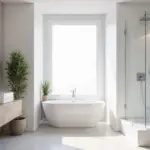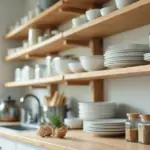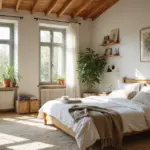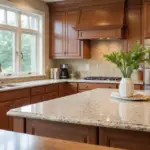Your kitchen isn’t just a cooking space—it’s where life happens. As someone who’s spent nearly a decade blending British design sensibilities with South Asian influences, I’ve seen how contemporary kitchen design has evolved to embrace both aesthetic beauty and practical functionality.
Whether you’re planning a complete renovation or looking for inspiration to refresh your current space, these 23 ideas will help you create a kitchen that’s both cutting-edge and comfortable. Let’s explore how to transform your kitchen into a contemporary masterpiece that reflects your personal style while enhancing your daily experience.
1. Embrace Minimalist Elegance with Sleek, Handleless Cabinets
Handleless cabinets have become the hallmark of contemporary kitchen design, offering clean lines and uninterrupted surfaces that instantly modernize any space. The beauty lies in their simplicity—without protruding handles, your eye glides smoothly across the kitchen, creating a sense of spaciousness and calm. Several clever mechanisms make these cabinets functional: push-to-open systems that respond to gentle pressure, recessed J-pulls that provide a subtle grip, or sophisticated electronic touch systems that offer hands-free operation.

Material selection is crucial for achieving the perfect handleless look. High-gloss lacquers create dramatic, reflective surfaces that bounce light around the room, while matte finishes offer sophisticated depth without showing fingerprints. For warmth without visual clutter, consider sleek wood veneers that bring natural texture while maintaining the minimalist profile essential to contemporary kitchen design.
The magic happens when you pair these sleek cabinets with contrasting elements—perhaps matte black handleless units against a light wood countertop, or crisp white cabinetry with brass accents that catch the light. Here’s where it gets interesting: these seemingly simple cabinets become the perfect backdrop for more expressive design choices elsewhere.
2. Illuminate Your Space with Statement Pendant Lighting
Lighting transforms a contemporary kitchen from merely functional to absolutely breathtaking. Pendant lighting, in particular, offers that perfect blend of task illumination and artistic expression that modern kitchens crave. The right pendants create focal points that draw the eye upward, adding dimension to your space while providing essential light exactly where you need it—over islands, dining areas, or sink stations.

What I love about contemporary pendant lighting is its incredible versatility. Glass pendants with clean lines offer ethereal elegance, while metal fixtures in brushed nickel or matte black provide industrial edge. For something unexpected, concrete pendants bring textural interest, and natural materials like wood or rattan soften the sometimes austere feel of contemporary kitchen design. The trick is balancing scale—for islands under 6 feet, two medium-sized pendants create perfect symmetry, while larger islands might need three or more to maintain visual weight and proper illumination.
Picture this: a cluster of mini-pendants at varying heights above your kitchen island, creating not just light but a sculptural installation that transforms the entire feel of your space. The surprising part is how these seemingly decorative elements can completely alter your kitchen’s ambiance from day to night, practical by morning and dramatic by evening.
3. Bring the Outdoors In with Natural Wood and Stone Accents
Contemporary kitchen design often risks feeling cold or sterile, which is precisely why incorporating natural elements creates such magic. Wood and stone accents introduce warmth, texture, and a grounding quality that balances the clean lines and technological features of modern kitchens. These materials connect us to nature, creating a sense of calm and wellbeing that transforms the kitchen from a purely functional space into a nurturing environment.

When selecting natural materials for your contemporary kitchen, consider how they’ll interact with the overall aesthetic. Walnut adds rich, dark warmth, while rift-cut oak offers more subtle, linear grain patterns that complement minimalist designs. For stone, honed granite or marble brings organic patterning without the high shine that can feel dated. The key is balance—use natural elements as thoughtful accents rather than overwhelming the space. A wood island countertop against sleek cabinetry, or a dramatic stone backsplash as a focal point, creates the perfect tension between natural and manufactured elements.
Let that sink in for a moment: the most forward-thinking contemporary kitchen design doesn’t reject natural materials—it celebrates them in new, thoughtful ways. This connection to nature creates a kitchen that feels both timeless and of-the-moment, setting the stage for the spatial flow that’s equally important in modern design.
4. Maximize Openness with a Seamless Island-Centric Layout
The heart of contemporary kitchen design often revolves around a well-conceived island that anchors the space while promoting movement and social interaction. Island-centric layouts have revolutionized how we experience kitchens, transforming them from isolated work zones into the social hubs of our homes. A thoughtfully designed island creates natural pathways around the kitchen, improves workflow efficiency, and provides a gathering point that invites connection.

To truly embody contemporary kitchen design principles, aim for seamlessness in your island layout. This means minimizing visual interruptions through integrated appliances that disappear behind matching panels, handleless cabinetry that creates unbroken lines, and continuous countertops that flow elegantly from perimeter to island. The color palette should remain cohesive, with subtle variations in tone rather than stark contrasts. Even the flooring should extend uninterrupted throughout the kitchen and into adjacent living spaces, blurring boundaries and expanding the perceived space.
It works something like this: as you eliminate visual clutter and create clean, continuous lines, the kitchen breathes more easily and functions more intuitively. This sense of openness sets the foundation for the materials that will define your contemporary kitchen’s character, starting with your countertops.
5. Upgrade to Durable and Chic Quartz Countertops
Quartz has emerged as the superstar material of contemporary kitchen design, and for good reason. Unlike natural stone that requires regular sealing and maintenance, quartz offers exceptional durability with minimal upkeep. Its non-porous surface resists staining and bacterial growth—crucial for busy kitchens—while providing consistent coloration and patterning that creates the clean, unified look that contemporary design demands.

The versatility of quartz is truly remarkable, with options ranging from crisp whites and creams to dramatic blacks and grays, even extending to blues and greens for more adventurous designs. For minimalist contemporary kitchen design, solid colors with subtle variations create sophisticated simplicity, while those seeking a more transitional look might choose quartz with veining that mimics marble or granite. Always view samples in your actual space before committing—the way quartz interacts with your specific lighting conditions can dramatically affect its appearance.
“Quartz countertops aren’t just beautiful—they’re practical investments that balance form and function perfectly in contemporary kitchen design.”
The heart of the matter is that your countertop choice sets the tone for your kitchen’s personality. While quartz creates a clean canvas, your backsplash offers the perfect opportunity to introduce color and character to your contemporary kitchen design.
6. Inject Personality with a Bold and Colorful Backsplash
Against the often-neutral palette of contemporary kitchen design, a vibrant backsplash becomes your opportunity to make a personal statement. This vertical surface occupies the perfect middle ground in your visual field—not so dominant as to overwhelm the space, yet prominent enough to create significant impact. A colorful backsplash energizes the kitchen while expressing your individual style, all without the commitment of more permanent elements like cabinetry.

Material options for contemporary backsplashes are delightfully diverse. Glass tiles in jewel tones create luminous surfaces that catch and reflect light, while ceramic tiles offer endless possibilities for color, pattern, and texture. For something truly distinctive, consider a single slab of dramatically veined marble or granite that creates an artistic focal point. Even budget-friendly options like peel-and-stick tiles can make a striking statement when chosen in bold colors or geometric patterns that complement your contemporary kitchen design.
- Consider a gradient mosaic that transitions from light to dark
- Explore geometric patterns for visual interest
- Look at metallic finishes for subtle glamour
- Don’t overlook large-format tiles for a cleaner look with fewer grout lines
The game-changer happened as I realized backsplashes could be more than just protective surfaces—they’re opportunities for artistic expression in contemporary kitchen design. This personalized touch creates the perfect counterpoint to the technological integration that defines modern kitchens.
7. Step into the Future with Smart, Integrated Appliances
Technology has revolutionized contemporary kitchen design, with smart appliances offering unprecedented convenience and efficiency. Imagine preheating your oven during your commute home, checking your refrigerator’s contents while grocery shopping, or having your coffee ready the moment you wake up. These aren’t futuristic fantasies—they’re the reality of today’s smart kitchens, where technology enhances both functionality and aesthetic appeal.

The beauty of smart appliances in contemporary kitchen design lies in their seamless integration. Refrigerators with interactive touchscreens blend into cabinetry while offering inventory management. Ovens with remote temperature control and automatic cooking programs take the guesswork out of meal preparation. Dishwashers with smart cycles detect load size and soil level to optimize water usage. Even smaller appliances like coffee makers and blenders can be controlled via voice commands or smartphone apps, creating a kitchen that responds intuitively to your needs.
You might be wondering about the learning curve with all this technology. The surprising part is how quickly these innovations become second nature, transforming your relationship with your kitchen. As appliances become smarter, contemporary kitchen design has also elevated utilitarian elements like range hoods into artistic statements.
8. Make a Statement with a Sculptural Range Hood
In contemporary kitchen design, functional elements are increasingly becoming focal points, and nowhere is this more evident than with sculptural range hoods. These architectural elements transcend their utilitarian purpose to become dramatic centerpieces that define the kitchen’s character. A well-designed range hood draws the eye upward, creating vertical interest while expressing your personal style through form and material.

The materials chosen for your statement hood dramatically affect the overall aesthetic. Stainless steel creates a sleek, professional look, while copper develops a living patina that adds warmth and character over time. Plaster hoods can be seamlessly integrated with the ceiling for a minimalist, architectural statement. Concrete offers industrial edge, and even glass can be incorporated for unexpected transparency. Whatever material you choose, ensure the design doesn’t compromise function—proper ventilation remains essential, requiring professional installation and appropriate fan power for your cooking style.
Here’s the catch: creating a statement with your range hood requires balancing its visual impact with the rest of your contemporary kitchen design. When one element makes a bold statement, others should play supporting roles. This principle of balance extends to another crucial aspect of kitchen design—lighting that enhances both function and mood.
9. Layer Lighting: Under-Cabinet, Ambient, and Task for Functionality and Mood
Lighting is the unsung hero of contemporary kitchen design, dramatically affecting both functionality and atmosphere. A well-planned lighting scheme involves thoughtful layering of different light sources to create a flexible, responsive environment. Single overhead fixtures simply can’t provide the nuanced illumination a modern kitchen demands—instead, think in terms of layers that can be adjusted throughout the day and for different activities.

The most effective contemporary kitchen lighting plans incorporate three essential types: ambient lighting provides general illumination through recessed fixtures or pendant lights; task lighting focuses bright, shadow-free light on work areas through under-cabinet strips or directional pendants; and accent lighting highlights architectural features or decorative elements. Under-cabinet lighting deserves special attention in contemporary kitchen design—it eliminates shadows on countertops, making food preparation safer and more pleasant while creating a warm glow that makes the kitchen inviting even when not in active use. Dimmers are essential for all lighting types, allowing you to transition seamlessly from bright morning productivity to intimate evening ambiance.
- Ambient lighting: Recessed ceiling fixtures, flush mounts, or chandeliers
- Task lighting: Under-cabinet strips, pendant lights over islands, interior cabinet lighting
- Accent lighting: Toe kick lighting, in-cabinet lighting, spotlights on artwork
- Decorative lighting: Statement pendants, sconces, or table lamps
Let me paint you a picture: a contemporary kitchen bathed in layers of light that can transform from a bright, energetic workspace to an intimate gathering spot with the adjustment of a few dimmers. This flexibility in lighting pairs perfectly with the versatility that open shelving brings to contemporary kitchen design.
10. Showcase Style with Open Shelving for Décor and Essentials
Open shelving has become a signature element of contemporary kitchen design, offering a perfect balance of functionality and display space. Unlike closed cabinetry that hides everything away, open shelves create an airy, spacious feeling while providing an opportunity to showcase beautiful items and add personality to your kitchen. They encourage a curated approach to kitchen storage, displaying only those items that are both useful and visually appealing.

The key to successful open shelving lies in thoughtful styling and organization. Group items by color, material, or function for visual cohesion—white ceramics arranged together create a clean, gallery-like display, while cookbooks organized by spine color add unexpected vibrancy. Plants, small artwork, and decorative containers can be interspersed with everyday essentials like glassware and dishes. The best contemporary kitchen designs use floating shelves with minimal brackets for a sleek, architectural look, often in materials that complement or contrast with the cabinetry below.
What complicates this is the need for regular maintenance—open shelves require commitment to organization and dusting. But the payoff is a kitchen that feels personal and lived-in rather than sterile and showroom-perfect. While open shelving puts items on display, the next element of contemporary kitchen design focuses on concealing the clutter that inevitably accumulates.
11. Conceal Clutter with Clever Walk-In Pantry Designs
The minimalist aesthetic of contemporary kitchen design demands thoughtful storage solutions, and a well-designed walk-in pantry offers the perfect answer. These dedicated spaces allow you to maintain clean, uncluttered countertops and cabinetry in the main kitchen while providing ample storage for food, small appliances, and kitchen gadgets. A walk-in pantry essentially serves as the engine room of your kitchen—keeping the necessary but not-always-beautiful elements hidden away while ensuring they remain perfectly organized and accessible.

Designing a contemporary walk-in pantry requires careful attention to several key elements. Accessibility comes first—adjustable shelving at various depths accommodates items of different sizes, while pull-out drawers and bins make it easy to access items stored at the back. Lighting is crucial; LED strips ensure every corner is well-illuminated. Organization systems like labeled containers, drawer dividers, and dedicated zones for different categories help maintain order. For a truly contemporary look, continue your kitchen’s material palette into the pantry, using similar finishes for shelving and flooring to create a cohesive aesthetic.
My breakthrough came when I realized a pantry isn’t just about storage—it’s about creating breathing room in the main kitchen that allows your contemporary design elements to shine without competition from visual clutter. With essentials tucked away, you can focus on statement pieces that add character, like a distinctive farmhouse sink.
12. Add Rustic Charm with a Modern Farmhouse Sink in Stainless Steel or Concrete
Farmhouse sinks have been reimagined for contemporary kitchen design, offering a perfect blend of rustic charm and modern functionality. Their distinctive apron-front design creates a focal point that softens the clean lines typical of contemporary kitchens, adding character without compromising the overall aesthetic. The generous, deep basin is incredibly practical for washing large pots and pans, making it as functional as it is beautiful.

For a truly contemporary take on this classic element, consider materials that update the traditional look. Stainless steel farmhouse sinks offer industrial edge and seamless coordination with modern appliances, while being remarkably durable and easy to maintain. Concrete sinks bring textural interest and can be customized in color and finish to complement your specific design scheme. The installation requires careful planning—these sinks are typically heavier than standard models and may require custom cabinetry—but the visual impact is well worth the investment.
You could compare it to wearing a vintage-inspired piece with an otherwise modern outfit—the farmhouse sink adds just enough character to keep your contemporary kitchen design from feeling cold or impersonal. This blend of old and new continues with modern innovations that enhance both convenience and hygiene.
13. Enhance Hygiene and Convenience with a Hands-Free Touchless Faucet
In today’s health-conscious world, touchless faucets have moved from commercial spaces into contemporary kitchen design, offering both practical benefits and sleek aesthetics. These innovative fixtures use infrared sensors to detect hand movement, activating water flow without physical contact. The technology is surprisingly simple: when the sensor detects motion, it triggers a solenoid valve that controls water flow, powered by batteries or a standard electrical connection.

The advantages extend far beyond the obvious hygiene benefits. Touchless faucets reduce water waste by running only when needed and stopping immediately when hands move away. They’re incredibly convenient when cooking with messy hands—no more awkwardly using elbows or wrists to operate the tap. From a design perspective, touchless faucets contribute to the clean, uncluttered look that defines contemporary kitchen design, with sleek profiles and minimal hardware. Many models allow temperature adjustment through a side lever or handle, combining touchless activation with traditional temperature control.
Things took an interesting turn when I installed a touchless faucet in my own kitchen and discovered how quickly it became indispensable—not just a luxury but a practical feature that transformed everyday tasks. This blend of technology and convenience aligns perfectly with another growing trend in contemporary kitchen design: sustainability.
14. Go Green with Sustainable and Eco-Friendly Materials like Bamboo and Recycled Glass
Contemporary kitchen design increasingly embraces sustainability, recognizing that beautiful spaces can also be environmentally responsible. Eco-friendly materials reduce environmental impact while creating healthier living environments, free from the VOCs and chemicals often found in conventional materials. This approach aligns perfectly with contemporary design principles that emphasize clean lines, natural elements, and mindful living.

Bamboo stands out as a particularly versatile sustainable material for contemporary kitchens. It regenerates rapidly—reaching maturity in just 3-5 years compared to hardwoods that take decades—while offering exceptional durability and a distinctive grain pattern. It works beautifully for flooring, cabinetry, and even countertops. Recycled glass, transformed into stunning countertops and backsplashes, diverts waste from landfills while creating unique, colorful surfaces that catch and reflect light. Other sustainable options include reclaimed wood, which brings character and history; linoleum, made from natural materials like linseed oil and cork dust; and low-VOC paints and finishes that improve indoor air quality.
“Sustainability in contemporary kitchen design isn’t just about being eco-conscious—it’s about creating spaces that feel more connected to nature and promote wellbeing.”
The ripple effects are enormous when you consider how these material choices impact both the planet and your daily experience in the kitchen. While focusing on sustainable materials, don’t overlook the smaller details that can make a big impact on your contemporary kitchen design.
15. Personalize Details with Unique Hardware Finishes in Brass, Copper, or Black
Hardware might seem like a minor detail in contemporary kitchen design, but these small elements can dramatically influence the overall aesthetic. Think of hardware as the jewelry of your kitchen—it adds personality, creates focal points, and can elevate even the simplest cabinetry. In minimalist contemporary kitchens with clean lines and simple surfaces, hardware offers a perfect opportunity to introduce texture, color, and visual interest without overwhelming the space.

Brass hardware brings warmth and sophistication, developing a beautiful patina over time that adds character and depth. Copper offers similar warmth with a more distinctive reddish tone that stands out against neutral cabinetry. Matte black hardware creates dramatic contrast against light cabinets while blending seamlessly with darker finishes. When selecting hardware, consider both appearance and functionality—the pieces should feel comfortable in your hand and operate smoothly. For a truly contemporary look, choose simple, geometric forms that complement rather than compete with your kitchen’s clean lines.
You may have noticed how these seemingly small details can tie together your entire design scheme, creating cohesion between larger elements. This attention to detail extends to creating functional spaces within your contemporary kitchen design that support your lifestyle, like a dedicated breakfast area.
16. Create a Cozy Breakfast Bar or Nook for Casual Mornings and Quick Meals
Contemporary kitchen design recognizes that kitchens are living spaces, not just cooking spaces. A thoughtfully designed breakfast bar or nook creates a dedicated area for casual dining, morning coffee rituals, or quick meals without the formality of a dining room. These spaces blend functionality with comfort, encouraging lingering conversations and creating natural gathering spots that enhance the kitchen’s role as the heart of the home.

Creating coziness within the clean lines of contemporary kitchen design requires thoughtful material selection and attention to comfort. Soft textures like upholstered banquette seating or cushioned bar stools invite people to relax and stay awhile. Warm lighting, particularly pendants hung at a lower height over the seating area, creates an intimate atmosphere. Natural materials like wood for the countertop or table add warmth and tactile appeal. Personal touches—artwork, plants, or decorative objects—make the space feel curated rather than clinical. In smaller kitchens, consider space-saving solutions like a peninsula with seating on one side, a narrow bar-height counter along a wall, or a banquette tucked into a corner with built-in storage beneath.
The crucial element is creating a space that feels distinct from the working areas of the kitchen while remaining connected to the overall flow. This balance between separation and integration is what makes contemporary kitchen design so livable. Speaking of livable elements, let’s explore how bringing plants into your kitchen can transform the atmosphere.
17. Infuse Freshness and Flavor with an Indoor Herb Garden on Your Countertop or Wall
Nothing brings a contemporary kitchen design to life quite like living plants, and an indoor herb garden offers both visual appeal and practical benefits. Fresh herbs elevate cooking with vibrant flavors and aromas while adding lush greenery that softens the hard surfaces typical of contemporary kitchens. This living element creates a connection to nature that counterbalances the technological aspects of modern design, adding warmth and personality to even the most minimalist space.

Creating a successful indoor herb garden starts with choosing the right varieties. Basil, mint, parsley, chives, oregano, thyme, and rosemary all thrive indoors with proper care. Consider your kitchen’s light conditions—most herbs need at least 4-6 hours of sunlight daily, so placement near a window is ideal. For contemporary kitchen design, the container style is as important as the plants themselves. Sleek, matching pots in concrete, ceramic, or brushed metal create a cohesive look. Vertical gardens mounted on walls save counter space while creating living art, and tiered stands make efficient use of vertical space while adding dimensional interest.
Think of it as bringing the garden’s spontaneity and life into the controlled environment of contemporary kitchen design—a perfect balance of nature and architecture. This focus on creating pleasurable daily experiences extends to another popular feature in modern kitchens: the dedicated coffee station.
18. Craft the Perfect Coffee Ritual with a Dedicated Coffee Station and Built-in Espresso Machine
For many of us, coffee is more than just a beverage—it’s a daily ritual that deserves thoughtful integration into contemporary kitchen design. A dedicated coffee station acknowledges this importance, creating a specialized area that enhances both the experience and efficiency of your morning routine. By consolidating all coffee-related items and equipment in one zone, you streamline workflow and elevate an everyday activity into something special.

The ultimate coffee station in contemporary kitchen design centers around a built-in espresso machine that integrates seamlessly with surrounding cabinetry. Unlike countertop models that consume valuable space and create visual clutter, built-in machines connect directly to water lines, eliminating refilling and creating a professional barista experience. Surrounding storage should be carefully planned—consider pull-out drawers for beans and supplies, vertical dividers for mugs, and specialized compartments for accessories. Ambient lighting creates atmosphere, while task lighting ensures precision in preparation. For a truly luxurious touch, include a small sink for easy cleaning and a refrigerator drawer for milk.
My experience went like this: after creating a dedicated coffee station in my kitchen, I found myself looking forward to mornings in a way I never had before. The thoughtful organization and beautiful design transformed a routine task into a moment of daily pleasure. This attention to creating joyful experiences extends to bold color choices that are increasingly popular in contemporary kitchen design.
19. Dare to be Dramatic with Rich, Dark Cabinetry in Navy, Charcoal, or Deep Green
While white kitchens have dominated for years, contemporary kitchen design is embracing the sophisticated drama of dark cabinetry. Deep, rich colors like navy blue, charcoal gray, and forest green create a sense of luxury and depth that lighter kitchens simply can’t achieve. These darker tones ground the space and create a perfect backdrop for metallic accents, natural materials, and thoughtful lighting to shine.

The key to successful dark cabinetry lies in balancing it with lighter elements to prevent the space from feeling heavy or small. Light countertops—particularly white marble or quartz—create striking contrast while reflecting light throughout the space. Backsplashes in reflective materials like glass or polished tile add luminosity. Strategic lighting becomes even more crucial with dark cabinetry; under-cabinet lighting, pendant lights, and well-placed recessed fixtures ensure the space feels bright and welcoming. For smaller kitchens, consider using dark cabinetry on just lower units or a kitchen island, with lighter elements above eye level to maintain an open feeling.
Do you see how huge that is? Dark cabinetry completely transforms the mood of contemporary kitchen design, creating spaces with depth and character that feel both timeless and on-trend. This bold approach pairs beautifully with another hallmark of contemporary kitchens: seamless integration of appliances.
20. Achieve Seamlessness and a Streamlined Look with Fully Integrated Appliances
Contemporary kitchen design celebrates clean lines and visual continuity, and fully integrated appliances are essential to achieving this seamless aesthetic. Unlike built-in appliances that maintain their own distinct appearance, integrated appliances disappear behind cabinetry panels that match the surrounding kitchen, creating an uninterrupted visual flow. When refrigerators, dishwashers, and other necessities blend invisibly into the cabinetry, the kitchen appears more spacious, architectural, and intentionally designed.

The benefits extend beyond aesthetics. Integrated appliances often utilize space more efficiently, with refrigerator drawers placed exactly where needed or dishwashers positioned strategically for optimal workflow. They create a quieter environment, as the cabinetry provides additional sound insulation. From a design perspective, integration allows for greater creativity and customization—appliances no longer dictate the kitchen’s look but rather conform to your vision. While the initial investment may be higher than standard appliances, the resulting cohesive design adds significant value to your home while providing the clean, uncluttered environment that defines contemporary kitchen design.
It’s similar to the difference between a bespoke suit and one off the rack—the customization creates a refined, tailored appearance that elevates the entire space. This attention to cohesive design extends to the thoughtful incorporation of metallic elements that add sophistication and visual interest.
21. Incorporate Metallic Accents for a Touch of Glamour with Gold or Stainless Steel Details
Metallic accents inject personality and refinement into contemporary kitchen design, creating points of visual interest and reflection that enliven the space. These gleaming details catch the light, adding dimension and movement to what might otherwise be static surfaces. They introduce luxury without ostentation, particularly when used with restraint as thoughtful accents rather than overwhelming features.

Different metals create distinctly different effects in contemporary kitchen design. Brushed gold brings warmth and sophistication, complementing both light and dark color schemes while adding a subtle glow. Stainless steel offers industrial edge and practicality, with exceptional durability and a cool, professional appearance. Copper provides warmth with a distinctive reddish tone that develops character over time. These metals can be incorporated through hardware, faucets, lighting fixtures, range hoods, and even appliance fronts. For maximum impact in contemporary kitchen design, limit yourself to one or two metal finishes throughout the space, creating cohesion rather than competition between elements.
The tricky part is finding the right balance—too little metal feels like a missed opportunity, while too much can become overwhelming. This principle of balance applies equally to the functional organization of your kitchen, particularly in how you arrange different activity zones.
22. Zone Your Kitchen for Cooking, Prep, and Socializing to Maximize Functionality
Contemporary kitchen design recognizes that today’s kitchens serve multiple functions simultaneously, from serious cooking to casual entertaining. Thoughtful zoning creates dedicated areas for specific activities, improving workflow while allowing multiple people to use the space comfortably. This approach transforms the kitchen from a purely utilitarian space into a multifunctional hub that supports your lifestyle.

Effective zoning starts with analyzing how you actually use your kitchen. The cooking zone should consolidate the stove, oven, and essential tools and ingredients. The preparation zone needs ample counter space, cutting boards, knives, and easy access to the refrigerator. The cleaning zone groups the sink, dishwasher, and waste disposal. A socializing zone might include an island with seating, separated from but visible to the cooking area. These zones can be defined through subtle design cues—changes in counter height or material, strategic lighting, or thoughtful placement of islands or peninsulas. In contemporary kitchen design, these functional considerations should feel intuitive rather than obvious, with zones flowing naturally into one another.
Let me show you another perspective: rather than thinking of your kitchen as one space, imagine it as a series of interconnected stations, each optimized for specific tasks but contributing to a cohesive whole. This functional approach to contemporary kitchen design ensures the space works as beautifully as it looks. The final touch that brings this functional beauty to life? The vibrant presence of living plants.
23. Introduce Life and Vibrancy with Indoor Plants for a Fresh and Inviting Kitchen Atmosphere
Plants are the perfect finishing touch for contemporary kitchen design, bringing organic shapes and living energy to spaces often dominated by hard surfaces and straight lines. Beyond their aesthetic appeal, plants improve air quality, reduce stress, and create a connection to nature that enhances wellbeing. They add color, texture, and movement that can’t be replicated by inanimate objects, making the kitchen feel more vibrant and alive.

Selecting the right plants for your contemporary kitchen requires considering both environmental conditions and design cohesion. Plants that thrive in humidity and variable temperatures work well—pothos, snake plants, and ZZ plants are nearly indestructible options for beginners. Herbs like basil, mint, and rosemary offer both beauty and functionality. For contemporary design, the containers are as important as the plants themselves; choose pots in materials that complement your kitchen’s palette—concrete, ceramic, or brushed metal in simple, geometric shapes maintain the clean aesthetic. Strategic placement maximizes impact: shelving displays, countertop clusters, hanging planters, or a statement plant in an empty corner can all transform the space without compromising functionality.
- For low light: Snake plant, ZZ plant, pothos
- For high humidity: Ferns, peace lily, spider plant
- For culinary use: Basil, mint, chives, thyme
- For color: Croton, purple heart, flowering kalanchoe
The potential here is enormous—plants bring life to contemporary kitchen design in a way no other element can, softening the precision of modern aesthetics with organic, unpredictable growth that makes the space feel truly lived-in and personal.
Bringing It All Together
Contemporary kitchen design is about creating spaces that balance beauty and functionality, technology and warmth, minimalism and personality. Whether you embrace the drama of dark cabinetry, the seamless integration of smart appliances, or the organic touch of indoor plants, the most successful contemporary kitchens reflect your unique lifestyle and preferences while adhering to principles of clean lines, thoughtful organization, and quality materials.
The beauty of contemporary design lies in its flexibility—you can incorporate elements that resonate with you while maintaining the overall aesthetic of simplicity and intentionality. Perhaps you’ll combine handleless cabinetry with a statement range hood, or pair sustainable materials with metallic accents. Whatever combination you choose, focus on creating a space that not only looks stunning but supports the way you live, cook, and connect with others. After all, the most successful contemporary kitchen design is one that feels distinctly yours while embracing the forward-thinking principles that define modern living.






